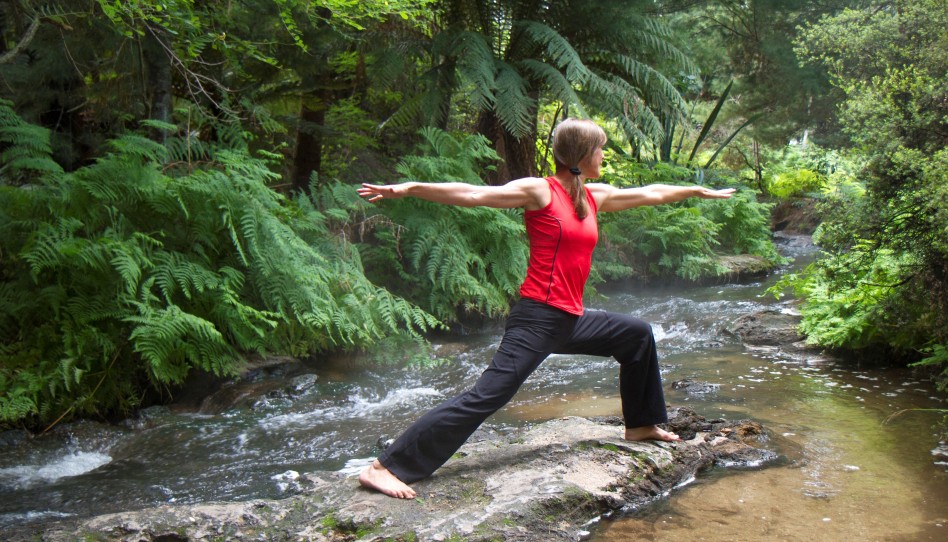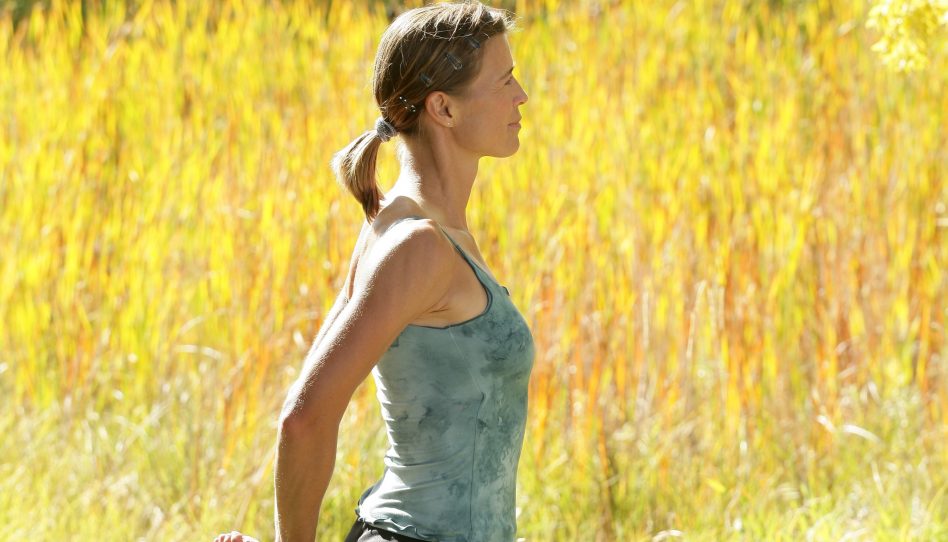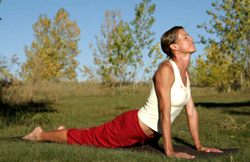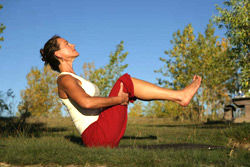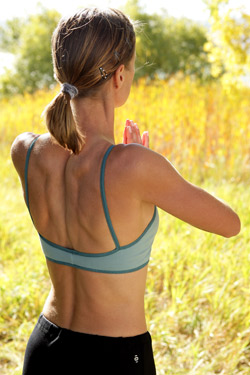Power to the Peaceful: An Interview With Joe Haddad
One of the great beauties of yoga is that it is not just about taking us from a negative state of mind to feeling “normal.” Yoga aims much higher, seeking to put practitioners in touch with a state of peace, joy and equanimity that yogis insist is everyone’s birthright. The key is getting your mind to work for you, not against you. People who are stressed, unhappy, angry or worried tend to live in a state of physiological arousal. Their sympathetic nervous system (source of the “fight or flight” response) may be activated most of the time. Slow, regular breathing tends to shift the balance to the relaxing and restorative parasympathetic nervous system (source of the “feed or breed” effect), which can help people tap into the joy that lies at our core.
Yoga also teaches that the more you have certain thoughts, or certain kinds of thoughts, the more likely you are to have them in the future. These are like mental grooves in our brain, and they tend to get deeper over time. Modern science has confirmed this as truth with new understandings of neuroplasticity. Scientists now understand that the more you think or do something, the stronger the neural pathways become that connect the specific brain cells (neurons) involved. An interesting study was published in 2004 that demonstrates these findings. In the study, scientists studied the brain activity of Tibetan monks and novice meditators before and during meditation; because of their regular practice, the monks’ brains were more active during meditation. (The study was published in the Proceedings of the National Academy of Sciences, and is available via PubMed.) Thus, the more you react with anxiety or beat yourself up emotionally, for example, the more likely you are to do it again and again.
Before a pattern can be changed, however, we first need to see it clearly. We are often unaware of recurrent thoughts that may be undermining our health and wellbeing. Part of the yogic remedy is to consciously tune in to your inner dialogue. A good place to start is during asana practice: If we have fearful or self-critical thoughts during practice, it’s a pretty good bet we’re having similar ones at other times, and these thoughts may be limiting the joy in our lives. The habit of self-study that we cultivate on our yoga mats can spread to a broader awareness of mental habits, thereby enabling us to release those that do not serve us.
Our interviewee, Joe, is discovering this for himself on the yoga mat. When Joe told me yoga was his lifeline, I wanted to understand more. Joe’s story is very different than that of our previous interviewee, Jim Thorne (“Yoga At Any Age”), who has been doing yoga for many years. Joe’s experience with yoga is relatively new, but the effects it’s having on his life, and what he’s endured, make it equally powerful He spent 14 of his first 19 years a stone’s throw from Beirut, which was the center of bombing throughout the Lebanese civil war. (Note: For privacy reasons, Joe has asked that his last name be changed in this article.)
Take The Magic Step: Hi Joe. Can you start by telling us what yoga means to you?
Joe Haddad: In the last few years, I’ve been experiencing mental and physical difficulties. Yoga has become my lifeline and has given me hope. When I come to class and we begin, I don’t think of anything else except what I’m doing on the mat. I finally understand the body/mind connection piece that people talk about but I never believed in.
That’s very powerful. Can you fill us in on your upbringing in Lebanon?
Yes. In 1975, when I was 5 years old, the Lebanese civil war began. It was still going on when I left at 19. Every year there was a different reason for the war.
What was that like for you?
I was a child, so on a certain level I accepted the war and it seemed normal to me. We were 10 minutes from Beirut, which became the center of the war. I got used to it, I suppose, but I was scared inside.
What was a “normal” life like for you?
When the bombs weren’t falling, we played soccer. Soccer was the king, especially during the World Cup years. We ate, drank, went to school – the usual things – until the fighting started; then we all hid. Everything, like can I go out to play, or exercise, or go to school today, depended on whether it was a safe time to go outside.
You left at 19? Were you with your family?
I had dreamed of going to America since I was 12. But when I left, I left without my family. People tried to escape on fishing boats that went to Cyprus, Greece. That night, a crowd of us boarded a ship without lights and tried to motor safely without detection. Air patrol spotted our movement and started bombing us. That experience – being in the wide-open sea like a sitting target – was the most frightening of my life.
How did you get to the United States?
Because I spoke French, I was allowed to immigrate to Montreal. I went to engineering college and had a wonderful community. It was hard to leave, but it was the high-tech boom, so in 1997 a recruiter from USWest in Denver contacted me, and I went. Denver scared me – I knew nobody, and at that time, there wasn’t much going on. I also got fat! I was eating at Taco Bell every day and gained 16 pounds. When I looked down at the number on the scale, I became a salad person at night and made it to the gym every day.
When did you first try yoga?
The first time I did yoga was in 2000 on my honeymoon in Hawaii. I mainly went to make my in-laws happy, but ended up liking it enough to go everyday we were there. That was a big year for me – not only did I get married, but I did my first BolderBoulder 10K running event.
You also run? When did you become a runner?
My wife, Erin, was my inspiration. She’s a great runner. It was one of the reasons I fell in love with her. I’d come over for a visit and it would be snowing outside. I’d be cozy and warm inside, but she’d always suit up and run through the elements. Eventually, she convinced me to join her. We even trained in Lebanon. I remember proudly telling my brother we had just run 8 miles. He look alarmed and asked me what happened to my car. [laughs]
Sounds like life was good, yet you’ve talk about things shifting. What happened?
I got hit, like many others, in 2001 when the stock market and tech stocks fell. Then, in rapid succession, 9/11 happened, and my father had a stroke along with kidney failure and strong depression. Erin and I got pregnant in 2004, and my job was in jeopardy. I developed huge feelings of frustration – so much was out of my control and I wasn’t able to help my father. I became nervous and anxious all the time. When the baby was born I stopped running, and I’m sure that didn’t help my anxiety. By 2006, my physical body began to react. I developed problems with muscle tension that inhibited my movements. I had muscle tremors and shortness of breath.
What did you do?
I wish I had thought about yoga then. I saw many doctors; some guessed [multiple sclerosis], others Parkinson’s. I had MRI’s of my brain, neck, and back – all the tests showed nothing. By September 2006, I had been to the emergency room twice with anxiety attacks and, as before, they couldn’t find anything physically wrong. In October I went to the Mayo Clinic for full comprehensive neurological testing. They said I was lucky. The results of all those tests showed that my physical symptoms had no neurological basis but were a result of my stress and anxiety.
How did you find your way back to yoga?
Erin suggested I go. When she said that it rang true – yes, I should go!
Can you tell us how yoga feels for you?
During yoga, most of my anxiety disappears, and for the whole night I feel peaceful. The next morning, symptoms may return, so I plan on trying a morning class and see how that helps my day.
What do you mean “your symptoms disappear?”
During class I am able to focus, and I don’t think about anything else. I can measure my body. In that I mean my past fears of a neurological disorder, like MS or Parkinson’s, aren’t valid because I can get my body to do what I want, even if I have to move very slowly because of the muscle tension. I can see my weakness and anxiety are mind-related. Finally, I understand what people mean when they talk about the mind/body connection and how one affects the other. You can’t ignore problems with one without the other suffering.
Joe, that’s a huge lesson in a short time.
It is. Yoga gets me out of my head. It’s a time for peace – a peaceful me. Therapists have also given me some exercises and mediation tapes to do at home, though I don’t do them very often. It’s harder at home. I like being in class with the same, friendly faces and group support. There’s never any judgment, it’s very comfortable.
With the shortness of breath you’ve experienced, how does yoga’s emphasis on breath affect you?
I’m starting to learn to use my breath, but it’s still hard. Sometimes I feel like I’m not getting enough air, but at least I know now this is stress-related. I just move at my own pace. The other day I discovered when I breathe deeply, it helps in my transition from upper dog to downward dog – it makes the pose easier!
Do you have a favorite pose?
I like pigeon because I can do it! I also really like the time we take at the beginning of class to set an intention. I always make the same intention: to honor my body – you provide so much for me, I am going to provide for and take care of you.
Do you have any advice for beginners, now that you’re such an old-timer?
Go at least three times a week. I definitely recommend yoga to anyone who’s able. Especially if you experience physical symptoms that relate to fear or anxiety, or even if you’re just feeling “out of order.” Symptoms of distress can be on so many levels. Yoga is preventive medicine. Even if life is smooth now, it prepares you, builds you up for challenges. It’s like preventing war with peace.
Can you tell if you’re progressing in your yoga practice? I certainly see it.
I can – I could barely move during my first class! The physical poses are getting stronger and more familiar. Best of all, I’m discovering a connection to my self – I’m starting to feel whole again.
Beautiful! What is yoga’s role in your future?
It’s going to be a very important part of my future. Yesterday I joined the health club on a family membership so I’ll be able to come to class anytime. I also started running with Erin again a few days ago. And, it’s my birthday and tomorrow my wedding anniversary!
Happy birthday and congratulations Joe!
Note: The U.S. Department of Defense has begun to recognize the potential of one form of yoga, Yoga Nidra, in treating Post-Traumatic Stress Disorder. The results from a small (9-person) clinical trial at Walter Reed Army Medical Center that concluded last fall were encouraging enough to warrant an expanded, 100-person trial, due to start in the fall of 2008. Meanwhile, Walter Reed has integrated Yoga Nidra, which focuses on self-awareness, into its treatment plan for active-duty soldiers returning from Afghanistan and Iraq. For more information, see this interview with the clinical trial’s director.
- Posted October 17, 2007
© Copyright 2007-2024 by Take The Magic Step®. All Rights Reserved.
